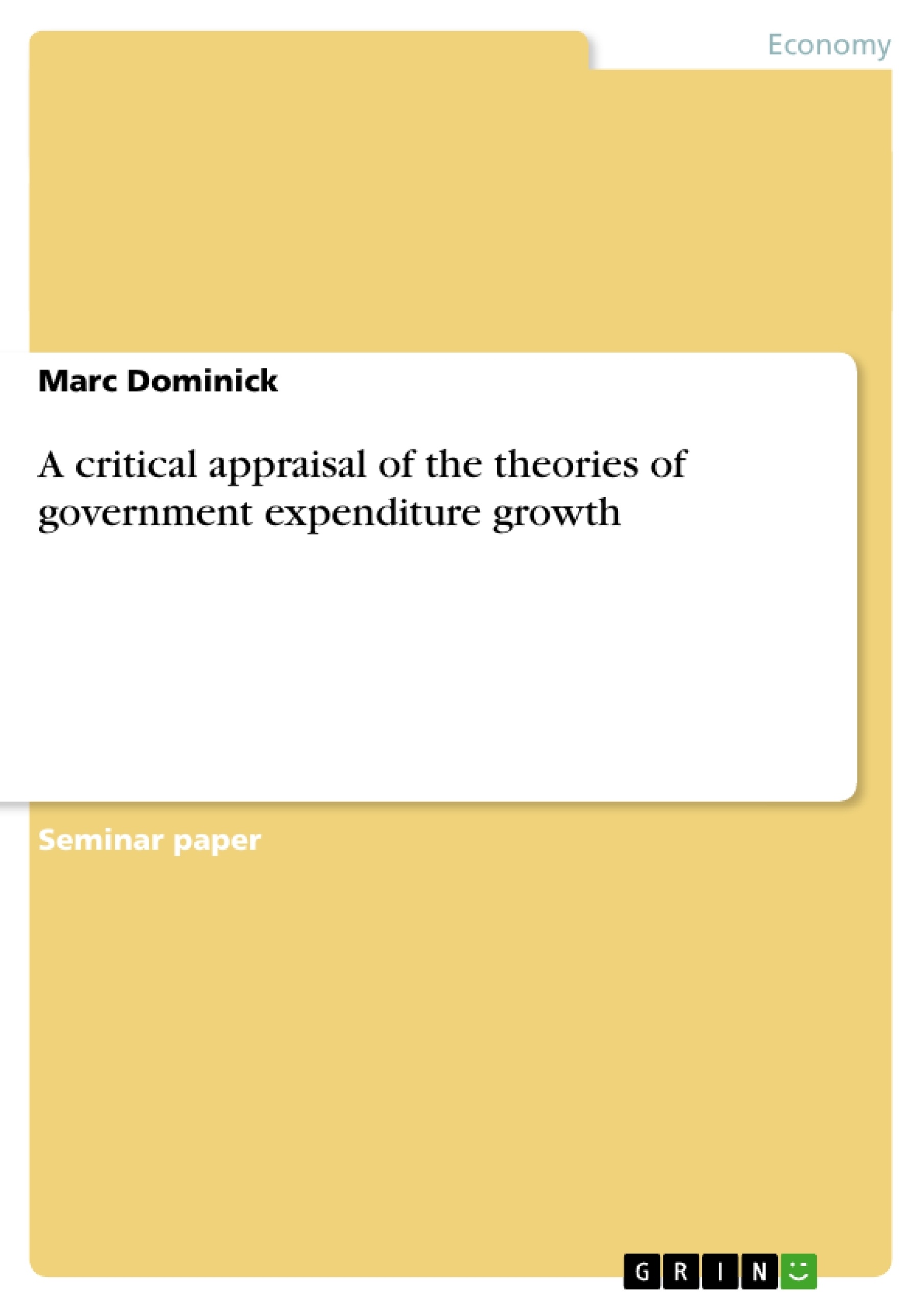Excerpt
Table of Contents
1 Introduction
1.1 Basic problem and objective of the study
1.2 Outline of the study
2 Macro models
2.1 Wagner’s “law”
2.1.1 Explanation and assumptions
2.1.2 Criticism and value of the theory
2.2 The Peacock - Wiseman hypothesis
2.2.1 Explanation and assumptions
2.2.2 Criticism and value of the theory
3 Micro models
3.1 Baumol’s model of unbalanced productivity growth
3.1.1 Explanation and assumptions
3.1.2 Criticism and value of the model
3.2 Leviathan model
3.2.1 Explanation and assumptions
3.2.2 Criticism and value of the model
4 Conclusion and further implications
1 Introduction
1.1 Basic problem and objective of the study
Since 1870 the growth in government spending has been a general trend in nearly all industrialised countries (Tanzi & Schuknecht 2000: 3). As this growth is not always welcomed and justified in terms of welfare and efficiency considerations economists developed a series of different theories seeking to explain this phenomenon.
The objective of this paper is to give an appraisal of four theories of government expenditure growth and to provide an overview of the implications that are part of it.
1.2 Outline of the study
This paper is structured in the examination of two macro models (Wagners “law” and
The Peacock - Wiseman hypothesis) and two theories (Baumol’s model and the Leviathan model) belonging to the micro models. Before each model is criticised a brief explanation of the theory and its assumptions are given. Chapter 4 presents the final considerations of the study which includes a conclusion and further implications.
For purposes of simplification this study applies the terms government expenditure growth, growth of the public sector and growth of government etc. as synonyms.[1]
2 Macro models
Macro models focus on the long-term rising trend of public expenditure. The term macro refers to the fact that a collection of factors result in an overall outcome (Bailey 1995: 44-45). Often aggregated variables like the GDP (gross domestic product) or the per capita income is used to determine government expenditure growth (Black et al. 1999: 87)
2.1 Wagner’s “law”
In 1883 Adolph Wagner stated that government expenditure rises at a faster rate than the output of the economy. He derived it from empirical findings on progressive, mainly Western European industrialising countries, where he examined changes in the ratio between public spending and the per capita real income. (Black et al. 1999: 87)
2.1.1 Explanation and assumptions
Wagner contended, on behalf of a country’s citizens demands there are three raisons d'être for an increase in government expenditure being greater than the increase in output of economy. Firstly, demands for services such as health and education grow faster than per capita income, which implies that citizens have an income elasticity of demand on these kinds of services that is greater than one. Secondly, to maintain an environment beneficial for economic progress, the state must increase its efforts and consequently its expenses in the sectors of law, protection and administration. Lastly, market failures such as monopolies, which might be the result of the need for high capital investment, cause expensive government interventions. (Black et al. 1999: 88)
In Wagner’s “law” an organic state model is assumed in which each individual can only have significance as part of the organism as a whole (Rosen 1999: 4-5). Moreover, the model requires rising per capital incomes, technological and institutional changes, a democratically governed state, and as aforementioned, it assumes high income elasticities of demand (Black et al. 1999: 87-88).
2.1.2 Criticism and value of the theory
A presumed organic view of the state is open to criticism by proponents of the mechanistic state model. The mechanistic view of the state emphasizes the individual which strives to create a state in a way that its personal interests are pursued best (Black et al. 1999: 88). Such an individual might get very soon to the point where it is not willing to accept higher taxes in order to finance further government’s expenditure.
Moreover, Wagner formulated his hypothesis after analysing countries in the era of industrialisation at the end of the 19th century. Not all assumptions he made can be transferred into the 20th or even the 21st century (Likierman 1988: 21). Lots of countries today are to be found in a process of post-industrialisation. The age of computers and worldwide networks did and do certainly bring dramatic technological changes, but instead of increasing governmental spending it is reasonable to argue that they tend to decrease number of employees and administrative work needed in the public sector.
Likierman (1988: 21) holds the view that Wagner’s “law” overstates the demand side for goods and services. The willingness or even the ability of the government to deliver additional services is not put to the question. No matter how big the existing size of the government might be, it will increase if income increases, thus efficiency considerations are not carried out.
Empirical examinations demonstrate that Wagner’s “law” can not be unequivocally called a law. Particularly more recent studies show that the estimated relationship between the increase in per capita income and the growth in government expenditure might be specious. Bohl (1996: 185-186) examined the G7 countries during the post-World War II period and found that Wagner’s “law” can only be supported by the results for two of them, Canada and the UK. Most of the early studies that corroborate Wagner do not go into the question of causality (Anwar et al. 1996: 167-168). To validate Wagner’s law, however, the direction of causality is crucial. Causality from government expenditures to economic development would be in contrast to Wagner and shore up the Keynesian school of thought which understands government spending as an exogenous factor.
[...]
[1] Though they are not necessarily the same
- Quote paper
- Marc Dominick (Author), 2002, A critical appraisal of the theories of government expenditure growth, Munich, GRIN Verlag, https://www.grin.com/document/44840
Publish now - it's free






















Comments